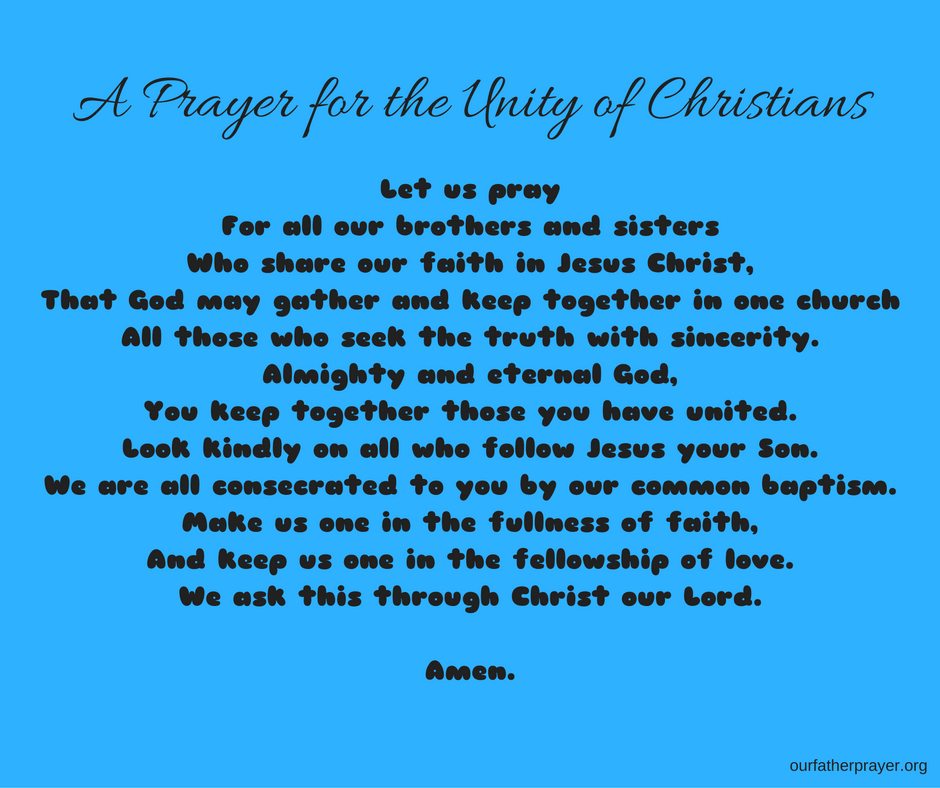Christ’s Prayer for the Church encapsulates a vital doctrine within Christian theology: the aspiration for unity, love, and truth among believers. As participants in the body of Christ, the Church emerges as a microcosm of divine intention—a collective designed to reflect God’s nature. The prayer of Christ, articulated during the Last Supper, is not merely a request; it is a profound declaration of the interconnectedness that ought to permeate the fabric of Christian existence.
At the heart of this supplication lies an enchanting metaphor: the image of unity as a harmonious symphony. Each believer represents an individual instrument, with distinct characteristics and capabilities. Together, these instruments create a musical masterpiece, resonating with the beauty of diversity unified under the baton of the Holy Spirit. This symphonic ideal serves as a powerful reminder that fragmentation within the Church is antithetical to its divine purpose. The dissonance brought on by discord serves only to weaken the collective witness to Christ’s love and truth.
This prayer for unity is deeply rooted in the relational nature of God Himself. The Holy Trinity—a divine fellowship of Father, Son, and Holy Spirit—highlights an eternal relationship characterized by love and mutual glorification. When Christ prays for the Church to be one, He invites believers to partake in this divine communion. This call to unity transcends mere tolerance; it is an exhortation to engage in earnest relationships, fostering an environment where love flourishes.
Love, the quintessential hallmark of the Christian faith, is intricately woven into the fabric of this prayer. It is an agape love, a selfless, unconditional commitment that seeks the good of the other. The Apostle Paul expounds upon this concept in his letters, where he emphasizes that without love, actions can easily devolve into hollow rituals. Therefore, unity cannot be a mere façade; it must be undergirded by genuine affection that catalyzes reconciliation and understanding among disparate factions within the Church. This love is an active force, capable of breaking down barriers and bridging gaps, assuring that every member of the body is valued and cherished.
However, unity is inextricably linked to truth. In a world awash with subjective opinions, the Church is called to uphold an unwavering commitment to the truth of the Gospel. Christ prayed, “Sanctify them in the truth; your word is truth.” This profound declaration illustrates that truth is not an abstraction but an embodiment of the character of Christ Himself. He is the Way, the Truth, and the Life—a living testament to the reality of God’s intentions for humanity.
The tension between love and truth is often palpable within ecclesiastical communities. The challenge lies in striking a balance between holding firm to doctrinal integrity while simultaneously extending grace. The New Testament offers a blueprint for this dynamic through the ministry of Jesus and the apostles. Their lives exemplified how profound love for individuals could coexist alongside the proclamation of sometimes uncomfortable truths. This is the essence of Christ’s prayer; it calls for a community that celebrates its diversity whilst remaining anchored in the bedrock of divine truth.
The Church, therefore, must embark on a journey of self-examination and reflection. What does it mean to embody unity, love, and truth in a contemporary context? The reality is that the external pressures from a polarized society weigh heavily on the body of Christ. Numerous interpretations of faith compete for acknowledgment, thereby challenging the notion of a unified Church. Nonetheless, the prayer of Christ stands as an irrefutable challenge to reconsider the ways in which believers can cultivate a deeper, more authentic fellowship. It calls for humility and the willingness to engage in difficult conversations while holding steadfast to the tenets of faith.
Moreover, fostering this unity entails an active engagement with community outreach—extending the hand of fellowship beyond denominational lines and actively participating in the common good. As Christians work collaboratively on issues such as poverty alleviation, social justice, and environmental stewardship, they symbolize the love of Christ in action, thus bearing witness to the truth that transcends individual congregational identities.
The metaphor of the body of Christ serves as another poignant depiction of the Church’s unity. Each member plays a crucial role, whether as a hand, foot, or eye—none more important than the other. This concept of interdependence invites believers into a deeper appreciation of their unique giftings while understanding that their purpose is not realized in isolation. In Christ’s prayer, there is an implicit acknowledgment that the strength of the Church lies not in its individual parts but in their collective pursuit of the mission given by the Savior.
As Christians reflect on Christ’s prayer for unity, love, and truth, they are invited into an ongoing process of sanctification. This process entails not only personal transformation but also the corporate maturation of the Church. The pursuit of unity is a lifelong journey, requiring intentionality and sacrifice, but the rewards are profound. In an age where division is rampant, the Church is called to be a beacon of hope, a testament to the redemptive power of the Gospel, and an embodiment of Christ’s ardent prayer. When believers come together, grounded in love and committed to the truth, they illuminate the path for others, drawing them into the enchanting reality of God’s grace.



